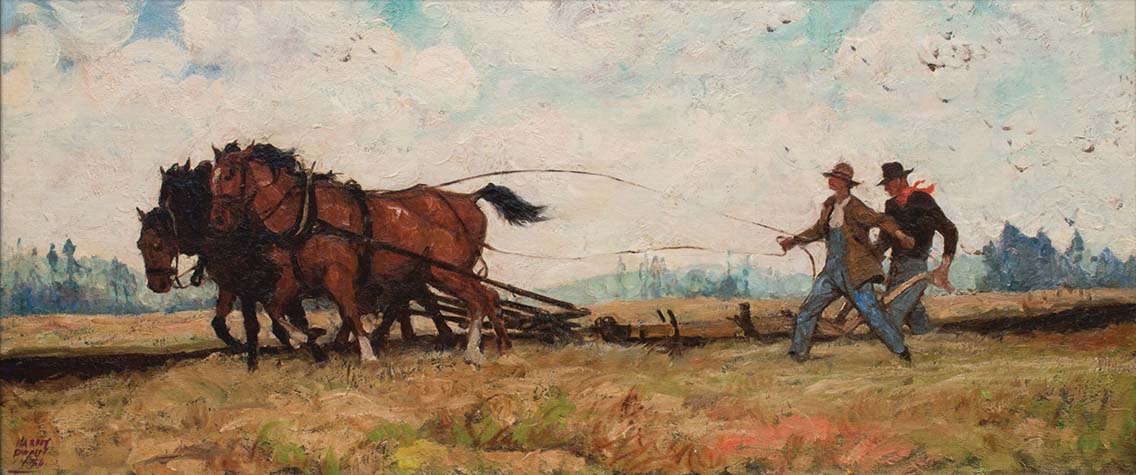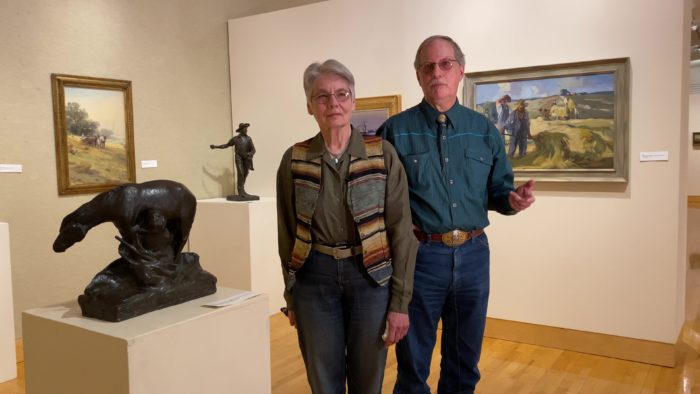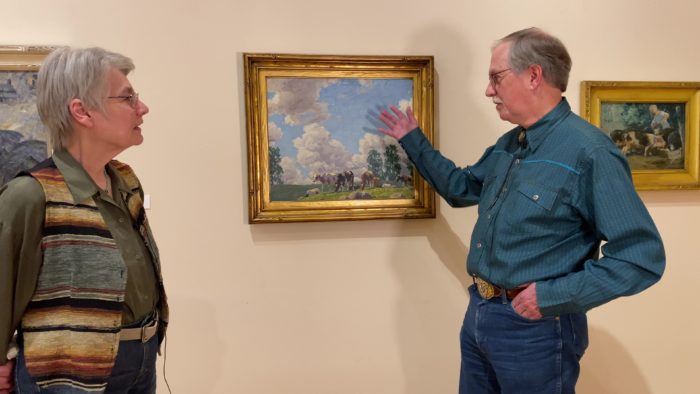
“A fragment of a culture and a civilization that is no more,” a conversation with Mark and Carol Moseman
Closing this weekend is the exhibition Agrarian Spirit in the Homestead Era: Artwork from the Moseman Collection of Agrarian Art at the Albrecht-Kemper Museum of Art in St. Joseph, Missouri. The very first public showing of this collection, Agrarian Spirit in the Homestead Era features a selection of 60 paintings, drawings, and sculptures depicting the people, places, and daily activities of the 1850s to the 1940s. This exhibition showcases artwork collected by David City, Nebraska couple Mark and Carol Moseman over the past several decades.
Agrarian Spirit in the Homestead Era is the result of decades of risk-taking, thoughtful reflection, and experimentation. Jill Carlson, the AKMA’s Marketing and Communications Manager, sat down with the Mosemans to discuss how family history and nostalgia informed their decisions to create a lasting legacy through artwork.
Jill Carlson: Thank you for joining us today to discuss your collection. You’ve devoted your lives to collecting and preserving “Agrarian Art.” Why does this speak to you so much?
Mark Moseman: One of my earliest memories on the farm as a little boy was that my father and grandfather and the neighbors were putting up hay. They let me out in the field with them, they were watching out for me, carefully, because it’s dangerous. This was one of the very first things I saw on the farm and remember. I didn’t realize it at the time, but it’s a very important image.
JC: What does this artwork say about the people who were the homesteaders and who worked on the land?
MM: You have people working together for a common task—hands on. There is a lot of pride in what they do, getting the wagons stacked. There is a methodology to it. How you lay the hay, how you put it together.
JC: That reminds me of the “Midwestern work ethic.” How does this theme show up in the collection?
 MM: One of my favorite pieces is The Hay Field by Frank Nelson Wilcox. It is the only painting—major painting—that I’ve seen any place in the country that captures this. He knew this subject matter and he painted it honestly, and expressively and he captured motion here. That is capturing a moment, an instant in time, a fragment of a culture and a civilization that is no more.
MM: One of my favorite pieces is The Hay Field by Frank Nelson Wilcox. It is the only painting—major painting—that I’ve seen any place in the country that captures this. He knew this subject matter and he painted it honestly, and expressively and he captured motion here. That is capturing a moment, an instant in time, a fragment of a culture and a civilization that is no more.
Carol Moseman: It looks like it was painted yesterday. It’s gorgeous, it’s in beautiful condition. But it stayed in his family. This is the first time it’s out of the Wilcox family. That tells you that they thought it was important, too.
MM: We’re so lucky to have it. So lucky to have it as a gift to mankind, that it can say something important.
JC: Carol, you also grew up on a farm in Nebraska. You said one of your favorite pieces is Breezy Afternoon by Edward Volkert. What can you tell me about this one?
 CM: This is one of my favorite pieces for purely personal reasons. Volkert painted cows, and you see this same herd in a number of his paintings. But these cows could have come out of my own pasture. I mean, this could be Daisy, Mamie, and Zsa Zsa. When I was a kid, Daisy hated me, but Mamie and Zsa Zsa were my friends. Every time I see this, I think of that. I can close my eyes and I can smell the grass. I can smell the way they [the cows] smelled. I just love that painting for that. It gets the essence of cow.
CM: This is one of my favorite pieces for purely personal reasons. Volkert painted cows, and you see this same herd in a number of his paintings. But these cows could have come out of my own pasture. I mean, this could be Daisy, Mamie, and Zsa Zsa. When I was a kid, Daisy hated me, but Mamie and Zsa Zsa were my friends. Every time I see this, I think of that. I can close my eyes and I can smell the grass. I can smell the way they [the cows] smelled. I just love that painting for that. It gets the essence of cow.
MM: You see this horizon line? It’s not perfect. You see how it comes behind the cows? And you see how it goes in front of these trees? No one ever notices that. And it doesn’t matter. That’s not the point. It’s not how realistic it is. It’s that it has a great message, it’s strong. It was still one of Volkert’s favorite painting.
JC: I notice that the front of the exhibition catalogue has this great painting on the front cover of two people driving a team of horses in a field. What can you tell me about this piece?
MM: This is one of my favorite pieces in the collection, and it’s by Harvey Dunn. It’s called Sons of the Frontier. Harvey Dunn made a great painting here. Maybe the greatest painting of his career. I love it because it represents the collection, it’s iconic, it’s abstract and surreal. It’s all about the action and freezing that action. When you look at the painting, it freezes action.
JC: Time just stops when you look at it. Was that typical of Dunn’s work?
MM: The great illustrators in the golden age of illustration were able to essentially paint motion. You do that with tricks. When you look at this painting, you see birds flying around. They represent and you can imagine the wind. The birds are picking up worms and things from where it’s been plowed.
If you’ve done this before or been near it, you can almost smell the soil once the sod is broken. This also represents teamwork. The teamwork between domestic animals and men—a man and a boy. Teamwork between a son and a father. The motion is represented in the flying scarves, and the tails and the manes and the reins.
JC: You once said that Agrarian Art helps us understand our relation to the land and natural environment. Tell me the story about how you came across this painting. How did you acquire it?
CM: Isn’t that what is cool about painting? You can have ten different people look at the same painting and get ten different things out of it. That’s part of the idea of the collection. Somebody can see this in 50 years or 60 years, and have that same kind of experience.
MM: We’re really excited about this because this is the first time it has been shown publicly. No one knew it existed until we bought it. When we saw an image of it in American Artist Magazine, we immediately called a dealer and started to make a deal for it. We had been trying to buy a Harvey Dunn [piece] for probably 15 years. They never come up for sale because Harvey Dunn burned all of the art that he didn’t consider worthy of his pioneer heritage collection. His paintings just don’t come up at auction.
JC: It’s a real testament to its value that this one survived.
MM: This one was painted at the height of his skills. He was in his 50s. He had all of his mental facilities, all of his imagination for this. All of the skills of painting. He didn’t have these at age 20. He had them at age 50, and he had the perspective on his life.
This comes from his heart. It comes from his knowledge. Harvey Dunn taught other painters to paint from the heart—illustrate and paint as one thing. This is a piece of work that represents that.
JC: Thank you for sharing your collection with us!
—-
The exhibition will be on view until Sunday, June 6, 2021.
You can meet Mark and Carol on Saturday, June 5, 2021 at the “Meet the Collectors” event at the Albrecht-Kemper Museum of Art. This event is included in the price of admission. See more of Mark and Carol’s interview on the AKMA YouTube Channel.
The Albrecht-Kemper Museum of Art aims to enrich the community through the collection and exhibition of visual arts by providing education, creating unique experiences, and nurturing regional artists. The museum is open Tuesday to Friday from 10 AM to 4 PM, and Saturday and Sunday from 1 PM to 4 PM. Admission is $5 for adults, $2 for seniors, and $1 for students. Museum members and children under age 6 are free. To become a member, visit Albrecht-kemper.org. For more information about the exhibitions, call 816-233-7003.
Financial support for this exhibition was provided by the Missouri Arts Council and the St. Joseph Convention and Visitors Bureau.
Image Credits:
Edward Volkert (American, 1871-1935). Breezy Afternoon (not dated). Oil on canvas.
Harvey Dunn (American, 1884-1952). Sons of the Frontier, c. 1940. Oil on canvas.
Frank Nelson Wilcox (American, 1882-1964). The Hay Field, c. 1916. Oil on canvas.
Photos by Jill Carlson
Categorized in: Posts
